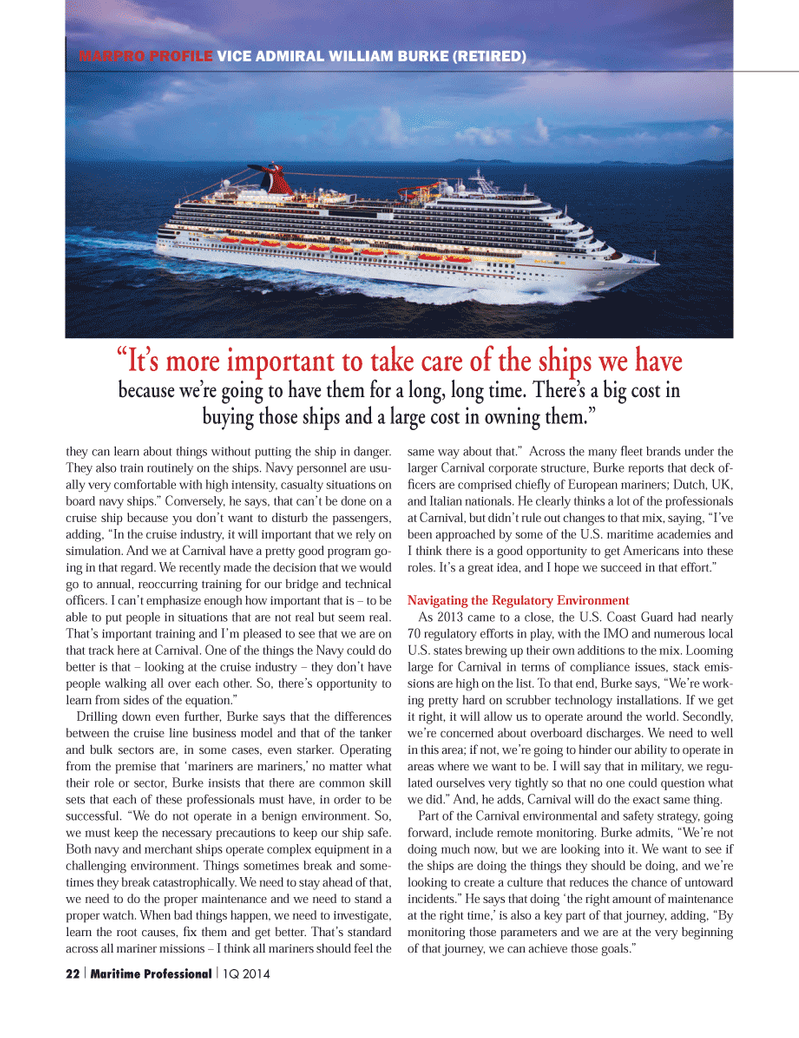
Page 22: of Maritime Logistics Professional Magazine (Q1 2014)
The Energy Edition: Exploration, Production & Transportation
Read this page in Pdf, Flash or Html5 edition of Q1 2014 Maritime Logistics Professional Magazine
MARPRO PROFILE VICE ADMIRAL WILLIAM BURKE (RETIRED) they can learn about things without putting the ship in danger.
They also train routinely on the ships. Navy personnel are usu- ally very comfortable with high intensity, casualty situations on board navy ships.” Conversely, he says, that can’t be done on a cruise ship because you don’t want to disturb the passengers, adding, “In the cruise industry, it will important that we rely on simulation. And we at Carnival have a pretty good program go- ing in that regard. We recently made the decision that we would go to annual, reoccurring training for our bridge and technical offi cers. I can’t emphasize enough how important that is – to be able to put people in situations that are not real but seem real.
That’s important training and I’m pleased to see that we are on that track here at Carnival. One of the things the Navy could do better is that – looking at the cruise industry – they don’t have people walking all over each other. So, there’s opportunity to learn from sides of the equation.”
Drilling down even further, Burke says that the differences between the cruise line business model and that of the tanker and bulk sectors are, in some cases, even starker. Operating from the premise that ‘mariners are mariners,’ no matter what their role or sector, Burke insists that there are common skill sets that each of these professionals must have, in order to be successful. “We do not operate in a benign environment. So, we must keep the necessary precautions to keep our ship safe.
Both navy and merchant ships operate complex equipment in a challenging environment. Things sometimes break and some- times they break catastrophically. We need to stay ahead of that, we need to do the proper maintenance and we need to stand a proper watch. When bad things happen, we need to investigate, learn the root causes, fi x them and get better. That’s standard across all mariner missions – I think all mariners should feel the same way about that.” Across the many fl eet brands under the larger Carnival corporate structure, Burke reports that deck of- fi cers are comprised chiefl y of European mariners; Dutch, UK, and Italian nationals. He clearly thinks a lot of the professionals at Carnival, but didn’t rule out changes to that mix, saying, “I’ve been approached by some of the U.S. maritime academies and
I think there is a good opportunity to get Americans into these roles. It’s a great idea, and I hope we succeed in that effort.”
Navigating the Regulatory Environment
As 2013 came to a close, the U.S. Coast Guard had nearly 70 regulatory efforts in play, with the IMO and numerous local
U.S. states brewing up their own additions to the mix. Looming large for Carnival in terms of compliance issues, stack emis- sions are high on the list. To that end, Burke says, “We’re work- ing pretty hard on scrubber technology installations. If we get it right, it will allow us to operate around the world. Secondly, we’re concerned about overboard discharges. We need to well in this area; if not, we’re going to hinder our ability to operate in areas where we want to be. I will say that in military, we regu- lated ourselves very tightly so that no one could question what we did.” And, he adds, Carnival will do the exact same thing.
Part of the Carnival environmental and safety strategy, going forward, include remote monitoring. Burke admits, “We’re not doing much now, but we are looking into it. We want to see if the ships are doing the things they should be doing, and we’re looking to create a culture that reduces the chance of untoward incidents.” He says that doing ‘the right amount of maintenance at the right time,’ is also a key part of that journey, adding, “By monitoring those parameters and we are at the very beginning of that journey, we can achieve those goals.” “It’s more important to take care of the ships we have because we’re going to have them for a long, long time. There’s a big cost in buying those ships and a large cost in owning them.” 22 | Maritime Professional | 1Q 2014
MP Q1 2014 18-33.indd 22 2/26/2014 1:22:50 PM

 21
21

 23
23
